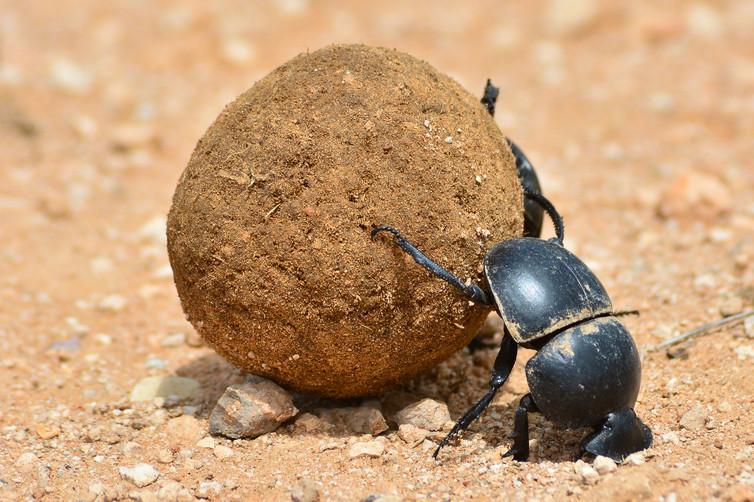Scientists have worked out how dung beetles use the Milky Way to hold their course
New research shows the insects use the brightness of different stars to work out which direction to go

Your support helps us to tell the story
From reproductive rights to climate change to Big Tech, The Independent is on the ground when the story is developing. Whether it's investigating the financials of Elon Musk's pro-Trump PAC or producing our latest documentary, 'The A Word', which shines a light on the American women fighting for reproductive rights, we know how important it is to parse out the facts from the messaging.
At such a critical moment in US history, we need reporters on the ground. Your donation allows us to keep sending journalists to speak to both sides of the story.
The Independent is trusted by Americans across the entire political spectrum. And unlike many other quality news outlets, we choose not to lock Americans out of our reporting and analysis with paywalls. We believe quality journalism should be available to everyone, paid for by those who can afford it.
Your support makes all the difference.Insects navigate in much the same way that ancient humans did: using the sky. Their primary cue is the position of the sun, but insects can also detect properties of skylight (the blue light scattered by the upper atmosphere) that give them indirect information about the sun’s position. Skylight cues include gradients in brightness and colour across the sky and the way light is polarised by the atmosphere. Together, these sky “compass cues” allow many insect species to hold a stable course.
At night, as visual cues become harder to detect, this process becomes more challenging. Some can use the light of the moon but one insect, the nocturnal dung beetle Scarabaeus satyrus, uses light from the Milky Way to orient itself. To find out exactly how this process works, my colleagues and I constructed an artificial Milky Way, using LEDs, to test the beetles’ abilities. We found that they rely on the difference in brightness between different parts of the Milky Way to work out which way to go.
Scarabaeus satyrus holds its course with apparent ease every night. They take to the air at dusk in the African Savanna, in search of the fresh animal droppings on which they feed. But they are not alone and, to escape competition from other dung beetles, they construct a piece of dung into a ball and roll it a few metres away from the dung pile before burying and consuming it.
To avoid returning to their starting point, they maintain a straight path while rolling their ball. Scientists discovered that the beetles could do this even on moonless clear nights. So in 2009, a group of researchers took some beetles on a trip to the planetarium in Johannesburg, and watched them try to orient themselves under different star patterns.

They found the beetles could hold their course well when the planetarium displayed just the Milky Way, the streak of light across the night sky produced by the disc-shaped arrangement of the stars in our galaxy. But the beetles became disoriented when only the brightest stars in the sky were shown.
What was still unclear was exactly what kind of compass cue the beetles extracted from the Milky Way. We knew, for example, that night-migrating birds learn the constellations surrounding the sky’s northern centre of rotation, much as sailors did before the advent of modern navigation systems. These constellations remain in the northern part of the sky as the Earth rotates, and so are a reliable reference for north-south journeys.
The planetarium experiments had shown that the beetles don’t use constellations of bright stars, but perhaps they could learn patterns within the Milky Way instead. My colleagues and I then proposed that the beetles might perform a brightness comparison, identifying either the brightest point in the Milky Way or a brightness gradient across the sky that is influenced by the Milky Way.
Artificial Milky Way
We used our artificial night sky to test this theory, constructing a simplified Milky Way streak that simulated different patterns of stars and brightness gradients. We found that the beetles became lost when given a pattern of stars within the artificial Milky Way. The beetles only maintained their heading when the two sides of the steak differed in brightness.

This suggests nocturnal beetles do not use the intricate star patterns within the Milky Way as their compass cue, but instead identify a brightness difference across the night sky to set their heading. This is similar to what their day-active relatives do when the sun is not visible but instead orient themselves using the brightness gradient of the daytime sky.
This brightness-comparison strategy may be less sophisticated than the way birds and human sailors identify specific constellations, but it’s an efficient solution to interpreting the complex information present in the starry sky – given how small the beetles’ eyes and brains are. In this way, they overcome the limited bandwidth of their information processing systems and do more with less, just as humans have learnt to do with technology.
This straightforward brightness comparison strategy is particularly effective over short distances. So although Scarabaeus satyrus is the only species known to hold its course in this way, the technique may also be used by many other nocturnal animals that perform short journeys at night.
James Foster is a postdoctoral fellow in functional zoology at the Lund University. This article originally appeared in The Conversation (theconversation.com)
Join our commenting forum
Join thought-provoking conversations, follow other Independent readers and see their replies
Comments